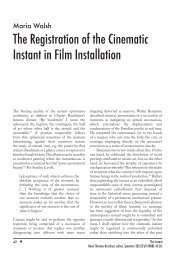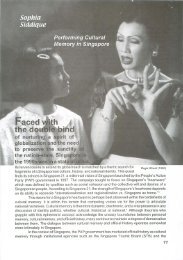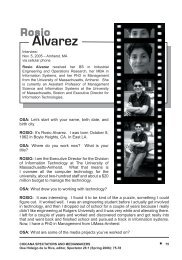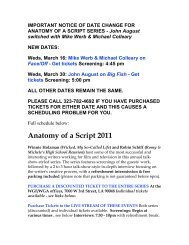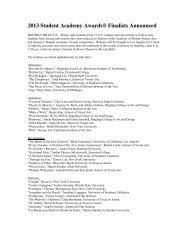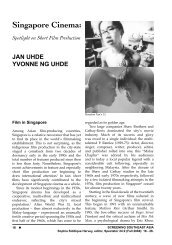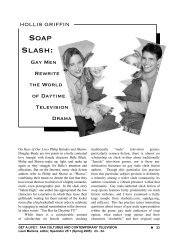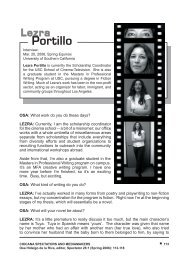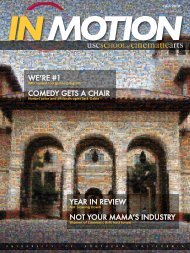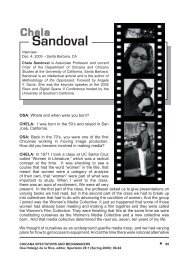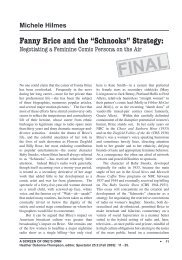IN MOTION (backup) V.3 - USC School of Cinematic Arts - University ...
IN MOTION (backup) V.3 - USC School of Cinematic Arts - University ...
IN MOTION (backup) V.3 - USC School of Cinematic Arts - University ...
You also want an ePaper? Increase the reach of your titles
YUMPU automatically turns print PDFs into web optimized ePapers that Google loves.
First Pitch: A View from the Trenches<br />
By Margaret M. Dunlap<br />
The third annual <strong>USC</strong> First Pitch was a night <strong>of</strong><br />
firsts. This year, the event moved from its previous<br />
home on the Zemeckis Center soundstages<br />
to a grand reception hall at the Peninsula Hotel in<br />
Beverly Hills. For the first time, senior undergraduates<br />
from the <strong>School</strong>’s writing division joined second- and<br />
third-year graduate students from the M.F.A. program for<br />
a night <strong>of</strong> five-minute pitches to managers, agents, and<br />
production executives.<br />
From 7:15 to approximately 9:30 p.m., 57 writers pitched<br />
their features and original television pilots a total <strong>of</strong> 969<br />
times to 43 executives. This was what it looked like from<br />
the inside.<br />
5:50 P.M.>> ARRIVAL<br />
“So, the script I’ve got for you tonight is…”<br />
We’re supposed to get to the hotel between 6:00 and 6:20,<br />
so naturally I’m driving down South Santa Monica Blvd.<br />
at 5:15. I take a scenic route over the last four blocks that<br />
includes Olympic Boulevard and Avenue <strong>of</strong> the Stars, and<br />
manage to arrive only ten minutes early.<br />
As I hand over the car to the valet I tell myself that I’m in<br />
good shape. The script is good. The pitch is good. I did<br />
this event last year. No reason to be nervous.<br />
Right.<br />
6 P.M.>> PREPARATION<br />
So that the executives and industry guests can relax before<br />
the event gets started, the students are all gathered in an<br />
out-<strong>of</strong>-the-way area that The Peninsula calls “The Board<br />
Room.” Tonight, it might be more appropriately called:<br />
“ The Panic Room.”<br />
Although many writers are at least outwardly calm and<br />
collected, Dean Elizabeth Daley will later describe the<br />
charged atmosphere as “having enough energy to light up<br />
all <strong>of</strong> Los Angeles.”<br />
The room is full <strong>of</strong> student writers, student interns getting<br />
a sneak peek at what they’re in for next year, wellwishing<br />
faculty and alumni, and last but not least, Mikkel<br />
Bondesson, our intrepid industry advisor. For the last<br />
semester Mikkel has been present for seminars, pitch<br />
workshops, and last-minute questions. Tonight, he brings<br />
us a final pep talk, and a gift: Tic Tacs. “Because the last<br />
thing we need tonight is a case <strong>of</strong> halitosis!”<br />
H allowed<br />
At least if he’s giving us something else to worry about,<br />
he’s also providing a solution. When the little boxes come<br />
around, I take one.<br />
6:45–9:30 P.M.>> THE PITCHES<br />
“So now, our protagonist is locked in…”<br />
Round one is by far the most nerve wracking. Last year, I<br />
got to the end <strong>of</strong> the first round and the agents I’d been<br />
pitching to suggested I rewrite my pitch. With only 30<br />
seconds between rounds, I figured I’d have to spend most<br />
<strong>of</strong> that time crossing the room instead. This year, it goes<br />
better. I don’t get a definite yes, but the guy I’m pitching<br />
to is into the story, and we discover that we’re both from<br />
Boston. “Which T-stop did you live on…? Oh sorry,<br />
that’s the bell, and I’ve only got 30 seconds to cross the<br />
room, gotta move on.”<br />
That’s pretty much how it goes for the next two hours.<br />
The time is broken down into slots numbered 1 to 25.<br />
Almost everyone is pitching 17 out <strong>of</strong> those 25 possible<br />
slots. My schedule is pretty broken up. I’ve got two rounds<br />
“on” and then two rounds free. Then five on, followed by<br />
three <strong>of</strong>f. Not everyone is like that. I compare schedules<br />
with one guy who pitched 13 rounds straight before his<br />
first break. Still, the execs only get two rounds <strong>of</strong>f during<br />
the entire evening.<br />
“As we move through Act II, the obstacles are coming thick<br />
and fast, and our protagonist hits a wall…”<br />
ground for film and television buffs, the historic hallways <strong>of</strong> The Culver<br />
Studios still seem to echo with the footsteps <strong>of</strong> Lucille Ball and Desi Arnaz, Cecil<br />
B. DeMille, Katharine Hepburn, Alfred Hitchcock, Laurel and Hardy, Harold Lloyd,<br />
David O. Selznick, and countless other Hollywood legends — all <strong>of</strong> whom created movie<br />
magic on this lively lot.<br />
The lot’s signature structure is its grand colonial mansion-<strong>of</strong>fice, which is fronted by<br />
sweeping green lawns, sculpted hedges, and flowering rose bushes. A replica <strong>of</strong> George<br />
Washington’s famous Mount Vernon residence, this registered historic landmark faces<br />
Culver City’s Washington Boulevard and is probably best known for its memorable cameo<br />
appearance in Gone With the Wind.<br />
Building renovations and new construction have enabled The Culver Studios to retain the<br />
charm <strong>of</strong> the past while accommodating today’s film, television, commercial, and music<br />
video producers who require the latest in fiber optic and digital capability. An infusion <strong>of</strong><br />
youthful energy, courtesy <strong>of</strong> students from the <strong>School</strong>’s Division <strong>of</strong> Film and Television<br />
Production, has also contributed to the rebirth <strong>of</strong> the legendary studio.<br />
An agreement between Michael Taylor, division chair, and Ron Lynch, president <strong>of</strong> The<br />
Culver Studios, has given production students access to available soundstages. Already<br />
more than 25 students have set up shop on the illustrious lot, sharing the facilities with<br />
current television and movie productions, including Arrested Development (Fox) and<br />
Skipping the Holidays (Revolution/Columbia).<br />
Somewhere about round 18, I can feel my brain turning<br />
to mush. I know my pitch backwards, but this is all about<br />
stamina now. At the table I just left, I found myself<br />
telling three managers, “So, I’ll let you know,” instead <strong>of</strong><br />
“ So, you’ll let me know?” I caught myself and made a joke<br />
out <strong>of</strong> it, but I’m not expecting a call from them anytime<br />
soon. Honestly though, I wasn’t expecting a call from<br />
them anyway. That’s one advantage to First Pitch: If a<br />
pitch goes badly, it can go badly only for five minutes.<br />
It doesn’t seem any easier from the other side <strong>of</strong> the table.<br />
At this point, everyone’s tired. And then, as I come <strong>of</strong>f a<br />
break and slide in opposite another agent, break the ice,<br />
and go into my pitch, something clicks. The pitch is flowing<br />
again, I’m not confusing my characters’ real names<br />
with the names <strong>of</strong> the people I’ve mentally cast in their<br />
roles, or getting my tongue caught on my teeth. The agent<br />
blinks out <strong>of</strong> his glassy-eyed stare. He laughs in the right<br />
places, he doesn’t laugh in the wrong places. I finish, and<br />
he says, “That sounds interesting. Why don’t you send me<br />
the script?”<br />
It’s not my first “yes” <strong>of</strong> the night, but it helps put the spark<br />
back in those last few rounds.<br />
9:30 P.M.>> <strong>IN</strong>FORMAL DESSERT RECEPTION<br />
“And then we move into Act III…”<br />
Before the first round <strong>of</strong>ficially began, <strong>USC</strong> <strong>School</strong> <strong>of</strong><br />
Cinema-Television writing division alumnus Jamie<br />
Vanderbilt described his horror <strong>of</strong> pitching, “You take<br />
essentially introverted people who are engaged in the most<br />
solitary <strong>of</strong> pursuits and force them to talk to other people…<br />
for minutes at a time!”<br />
It’s true that while writing, adrenaline rushes are few and far<br />
between. Sixty writers coming <strong>of</strong>f one simultaneously is<br />
something to behold. At the post-pitch reception, some <strong>of</strong><br />
my colleagues are definitely looking the worse for wear. One<br />
student tells me, “I just want to go home, throw myself on<br />
my bed, and cry.” The guy who has spent the evening<br />
telling and retelling the story <strong>of</strong> an African war orphan<br />
forced to become a child soldier looks like he’s been through<br />
a few campaigns himself.<br />
But while my throat is telling me to shut up and drink<br />
some tea with lemon, I’m feeling pretty good. Good enough<br />
to mix and mingle with a few executives who’ve stuck<br />
around for the dessert reception, I even pitch my story<br />
again. (The executive will call me the next morning and ask<br />
for my script.)<br />
And that’s not so unusual. Nearly everyone is tired, but the<br />
mood is positive. No executives fell asleep. More people<br />
were receptive, or at least polite, than not. Most <strong>of</strong> us have<br />
met people that we’d look forward to seeing again for six, or<br />
even seven, minutes at a time.<br />
All told, students received 506 requests to read their scripts,<br />
either that night, or filtering in over the next week or so.<br />
If previous years’ statistics are any guide, many writers<br />
will eventually find representation through contacts that<br />
they make at the event. A few might eventually have their<br />
work optioned.<br />
But really, that’s not even the point, because this is only the<br />
first pitch. The real marathon — <strong>of</strong> starting and building a<br />
career — is just beginning.<br />
“And that is the note <strong>of</strong> hope we go out on.”<br />
Famed Studio Welcomes Student Productions<br />
“<br />
This is a unique opportunity for our students to shoot their films in a historic studio setting<br />
and work side-by-side with pr<strong>of</strong>essional filmmakers,” said Taylor. “They will have<br />
access to stages, equipment, props, and sets, and to a back lot complete with a classically<br />
designed New York street.”<br />
One <strong>of</strong> the original cottages on the Culver Studios lot.<br />
fall 2004 in motion | 7




